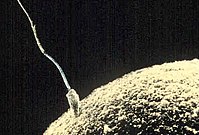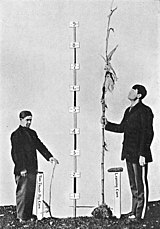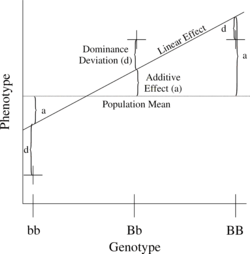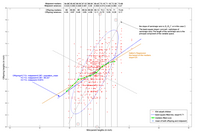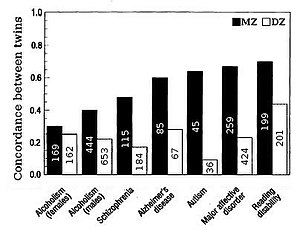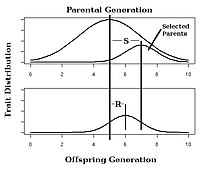A sperm fertilizing an egg in sexual reproduction is one stage of reproductive success
Reproductive success is defined as an individual's production of offspring per breeding event or lifetime.
This is not limited by the number of offspring produced by one
individual, but also the reproductive success of these offspring
themselves. Reproductive success is different from fitness in that
individual success is not necessarily a determinant for adaptive
strength of a genotype since the effects of chance and the environment have no influence on those specific genes.
Reproductive success turns into a part of fitness when the offspring
are actually recruited into the breeding population. If offspring
quantity is not correlated with quality this holds up, but if not then
reproductive success must be adjusted by traits that predict juvenile
survival in order to be measured effectively. Quality and quantity is about finding the right balance between reproduction and maintenance and the disposable soma theory of aging
tells us that a longer lifespan will come at the cost of reproduction
and thus longevity is not always correlated with high fecundity. Parental investment
is a key factor in reproductive success since taking better care to
offspring is what often will give them a fitness advantage later in
life. This includes mate choice and sexual selection
as an important factor in reproductive success, which is another reason
why reproductive success is different from fitness as individual
choices and outcomes are more important than genetic differences. As reproductive success is measured over generations, Longitudinal studies
are the preferred study type as they follow a population or an
individual over a longer period of time in order to monitor the
progression of the individual(s). These long term studies are preferable
since they negate the effects of the variation in a single year or
breeding season.
Nutritional contribution
Nutrition
is one of the factors that influences reproductive success. For
example, different amounts of consumption and more specifically
carbohydrate to protein ratios. In some cases, the amounts or ratios of
intake are more influential during certain stages of the lifespan. For
example, in the Mexican fruit fly,
male protein intake is critical only at eclosion. Intake at this time
provides longer lasting reproductive ability. After this developmental
stage, protein intake will have no effect and is not necessary for
reproductive success. In addition, Ceratitis capitata
males were experimented on to see how protein influence during the
larval stage affects mating success. Males were fed either a high
protein diet, which consisted of 6.5g/100mL, or a no protein diet during
the larval stage. Males that were fed protein had more copulations than those that weren't fed protein, which ultimately correlates with a higher mating success.
Protein-deprived black blow fly males have been seen to exhibit lower
numbers of oriented mounts and inseminate fewer females than more lively
fed males.
In still other instances, prey deprivation or an inadequate diet has
been shown to lead to a partial or complete halt in male mating
activity.
Copulation time lasted longer for sugar-fed males than protein-fed
flies, showing that carbohydrates were more necessary for a longer
copulation duration.
In mammals, amounts of protein, carbohydrates, and fats are seen
to influence reproductive success. This was evaluated among 28 female
black bears evaluated by measuring the number of cubs born. Using
different foods during the fall including corn, herbaceous, red oak,
beech, and cherry, nutritional facts of protein, carbohydrate, and fat
were noted, as each varied in percent compositions. Seventy-percent of
the bears who had high fat and high carbohydrate diets produced cubs.
Conversely, all 10 females who had low carbohydrate diets did not
reproduce cubs, deeming carbohydrates a critical factor for reproductive
success where fat was not a hindrance.
Adequate nutrition at pre-mating time periods showed to have the
most effect on various reproductive processes in mammals. Increased
nutrition, in general, during this time was most beneficial for oocyte
and embryo development. As a result, offspring number and viability was
also improved. Thus, proper nutrition timing during the pre-mating time
is key for development and long-term benefit of the offspring.
Two different diets were fed to Florida scrub-jays and breeding
performance was noted to have different effects. One diet consisted of
high protein and high fat, and the other consisting of just high fat.
The significant result was that the birds with the high protein and high
fat diet laid heavier eggs than the birds with the rich-in-fat diet.
There was a difference in the amount of water inside the eggs, which
accounted for the different weights. It is hypothesized that the added
water resulting from the adequate protein-rich and fat-rich diet may
contribute to development and survival of the chick, therefore aiding
reproductive success.
Dietary intake also improves egg production, which can also be
considered to help create viable offspring. Post-mating changes are seen
in organisms in response to necessary conditions for development. This
is depicted in the two-spotted cricket where feeding was tested for in
females. It was found that mated females exhibited more overall
consumption than unmated. Observations of female crickets showed that
after laying their eggs, their protein intake increased towards the end
of the second day. The female crickets therefore require a larger
consumption of protein to nourish the development of subsequent eggs and
even mating. More specifically, using geometrical framework analysis,
mated females fed off of a more protein rich diet after mating. Unmated
and mated female crickets were found to prefer a 2:1 and 3.5:1 protein
to carbohydrate, respectively.
In the Japanese quail, the influence of diet quality on egg production
was studied. The diet quality differed in the percent composition of
protein, with the high-protein diet having 20%, and the low-protein diet
having 12%. It was found that both the number of eggs produced and the
size of the eggs were greater in the high-protein diet than the low.
What was found unaffected, however, was the maternal antibody
transmission. Thus, immune response was not affected since there was
still a source of protein, although low. This means that the bird is
able to compensate for the lack of protein in the diet by protein
reserves, for example.
Higher concentrations of protein in diet have also positively
correlated with gamete production across various animals. The formation
of oothecae in brown-banded cockroaches based on protein intake was
tested. A protein intake of 5% deemed too low as it delayed mating and
an extreme of 65% protein directly killed the cockroach. Oothecae
production for the female as was more optimal at a 25% protein diet.
Although there is a trend of protein and carbohydrates being
essential for various reproductive functions including copulation
success, egg development, and egg production, the ratio and amounts of
each are not fixed. These values vary across a span of animals, from
insects to mammals. For example, many insects may need a diet consisting
of both protein and carbohydrates with a slightly higher protein ratio
for reproductive success. On the other hand, a mammal like a black bear
would need a higher amount of carbohydrates and fats, but not
necessarily protein. Different types of animals have different
necessities based on their make-up. One cannot generalize as the results
may vary across different types of animals, and even more across
different species.
Cooperative breeding
Evolutionarily,
humans are socially well adapted to their environment and coexist with
one another in a way that benefits the entire species. Cooperative breeding,
the ability for humans to invest in and help raise others' offspring,
is an example of some of their unique characteristics that sets them
apart from other non-human primates even though some practice this
system at a low frequency.
One of the reasons why humans require significantly more non-parental
investment in comparison to other species is because they are still
dependent on adults to take care of them throughout most of their
juvenile period.
Cooperative breeding can be expressed through economic support that
requires humans to financially invest in someone else's offspring or
through social support, which may require active energy investment and
time. This parenting system eventually aids people in increasing their survival rate and reproductive success as a whole.
Hamilton's rule and kin selection are used to explain why this
altruistic behavior has been naturally selected and what non-parents
gain by investing in offspring that is not their own. Hamilton's rule states that rb > c where r= relatedness, b= benefit to recipient, c= cost of the helper.
This formula describes the relationship that has to occur among the
three variables for kin selection take place. If the relative genetic
relatedness of the helper with the offspring is closer and their benefit
is greater than the cost of the helper, then kin selection will be most
likely be favored.
Even though kin selection does not benefit individuals who invest in
relatives' offspring, it still highly increases the reproduction success
of a population by ensuring genes are being passed down to the next
generation.
Humans
Some
research has suggested that historically, women have had a far higher
reproductive success rate than men. Dr. Baumeister has suggested that
the modern human has twice as many female ancestors as male ancestors.
Males and females should be considered separately in reproduction
success for their different limitations in producing the maximum amount
of offspring. Females have limitations such as gestation time
(typically 9 months), then followed by lactation which suppresses
ovulation and her chances of becoming pregnant again quickly.
In addition, a females ultimate reproductive success is limited due to
ability to distribute her time and energy towards reproducing. Peter T.
Ellison states, "The metabolic task of converting energy from the
environment into viable offspring falls to the female, and the rate at
which she can produce offspring is limited by the rate at which she can
direct metabolic energy to the task"
The reasoning for the transfer of energy from one category to another
takes away from each individual category overall. For example, if a
female has not reached menarche yet, she will only need to be focusing
her energy into growth and maintenance because she cannot yet place
energy towards reproducing. However, once a female is ready to begin
putting forth energy into reproduction she will then have less energy to
put towards overall growth and maintenance.
Females have a constraint on the amount of energy they will need
to put forth into reproduction. Since females go through gestation they
have a set obligation for energy output into reproduction. Males,
however, do no have this constraint and therefore could potentially put
forth more offspring as their commitment of energy into reproduction is
less than a females. All things considered, men and women are
constrained for different reasons and the number of offspring they can
produce. Males contrastingly are not constrained by the time and energy
of gestation or lactation. Females are reliant on the genetic quality of
their mate as well. This refers to sperm quality of the male and the
compatibility of the sperms antigens with the females immune system.
If the Humans in general, consider phenotypic traits that present their
health and body symmetry. The pattern of constraints on female
reproduction is consistent with human life-history and across all
populations.
A difficulty in studying human reproductive success is its high variability.
Every person, male or female, is different, especially when it comes to
reproductive success and also fertility. Reproductive success is
determined not only by behavior (choices), but also physiological
variables that cannot be controlled.
The Blurnton-Jones 'backload model' "tested a hypothesis that the
length of the birth intervals of !Kung hunter-gatherers allowed women
to balance optimally the energetic demands of child bearing and foraging
in a society where women had to carry small children and foraged
substantial distances".
Behind this hypothesis is the fact that spacing birth intervals allowed
for a better chance of child survival and that ultimately promoted
evolutionary fitness.
This hypothesis goes along with the evolutionary trend of having three
areas to divide up one's individual energy: growth, maintenance, and
reproduction. This hypothesis is good for gaining an understanding of
"individual-level variation in fertility in small-scale, high fertility,
societies( sometimes referred to by demographers as 'natural-fertility'
populations".
Reproduction success is hard to study as there are many different
variables, and a lot of the concept is subject to each condition and
environment.
Natural selection and evolution
To supplement a complete understanding of reproductive success or biological fitness it is necessary to understand the theory of natural selection.
Darwin's theory of natural selection explains how the change of genetic
variation over time within a species allows some individuals to be
better suited to their environmental pressures, finding suitable mates,
and/or finding food sources than others. Over time those same
individuals pass on their genetic makeup onto their offspring and
therefore the frequency of this advantageous trait or gene increases
within that population.
The same may be true for the opposite as well. If an individual
is born with a genetic makeup that makes them less suited for their
environment, they may have less of a chance of surviving and passing on
their genes and therefore may see these disadvantageous traits decrease
in frequency.
This is one example of how reproductive success as well as biological
fitness is a main component of the theory of Natural Selection and
Evolution.
Evolutionary trade-offs
Throughout
evolutionary history, often an advantageous trait or gene will continue
to increase in frequency within a population only due to a loss or
decrease in functionality of another trait. This is known as an
evolutionary trade-off. From Oxford Academic, "The resulting
'evolutionary tradeoffs' reflect necessary compromises among the
functions of multiple traits". Due to a variety of limitations like energy availability, resource allocation during biological development
or growth, or limitations of the genetic makeup itself means that there
is a balance between traits. The increase in effectiveness in one trait
may lead to a decrease in effectiveness of other traits as result.
This is important to understand because if certain individuals
within a population have a certain trait that raises their reproductive
fitness, this trait may have developed at the expense of others. Changes
in genetic makeup through natural selection is not necessarily changes
that are either just beneficial or deleterious but are changes that may
be both. For example, an evolutionary change over time that results in
higher reproductive success at younger ages might ultimately result in a
decrease in life expectancy for those with that particular trait.
